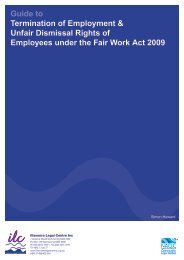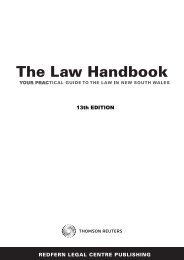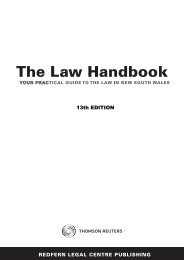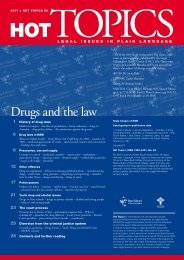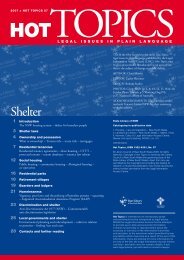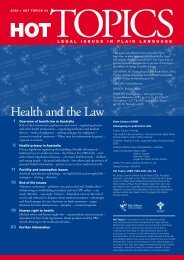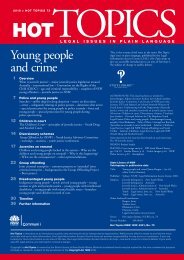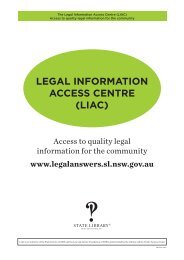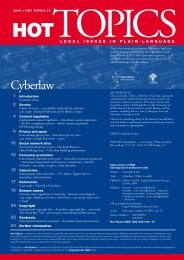Terrorism - Hot Topics 58 - Legal Information Access Centre
Terrorism - Hot Topics 58 - Legal Information Access Centre
Terrorism - Hot Topics 58 - Legal Information Access Centre
- No tags were found...
Create successful ePaper yourself
Turn your PDF publications into a flip-book with our unique Google optimized e-Paper software.
the crime being defined is not instead called a crime of‘intimidation’ or ‘compulsion’, since those concepts seemless serious than terrorising someone.Despite the lack of an international definition, Australianlaw defined terrorism in 2002, in response to the shockof 11 September 2001 terrorist attacks. In essence,Australia defines terrorism as certain types of seriousharm to people, property, public health or safety, oran electronic system, where it is intended to coercea government or an international organisation, or tointimidate the public, in order to advance a political,religious or ideological cause. There is an exception foradvocacy, protest, dissent or industrial action which isnot intended to cause serious physical harm to a person,endanger life, or seriously risk public health.While the Australian definition has been criticised, itis among the narrowest definitions of terrorism in allnational legal systems. The elements of the definition arecumulative, meaning that terrorism is only committed ifthere is serious harm, to intimidate the public or coercea government, for a political purpose. Almost all of thephysical acts covered by the definition are already crimesthemselves, and could, for instance, be prosecuted asmurder, assault, arson, malicious property damage,and so on. The Australian definition is also similar todefinitions used in Britain, Canada and New Zealand.Some elements of the definition are, however, rathervague, making the scope of the definition uncertain andunpredictable.freeDOm figHTersA major obstacle to international efforts to defineterrorism has been the problem of self-determination(or national liberation) movements. After the SecondWorld War, a new international political and legal orderwas created based on respect for the independence of‘peoples’ from colonial domination and oppression. Theaspirational idea of self-determination was enshrined inarticle 1(2) of the United Nations Charter 1945, and inthe first major post-war human rights instrument, theUniversal Declaration of Human Rights 1948 3 . Laterself-determination was transformed into a legally bindingcommitment by States in adopting the InternationalCovenant on Civil and Political Rights 1966 (ICCPR) 4and the International Covenant on Economic, Social andCultural Rights 1966 (ICESCR) 5 . Common article 1 ofthe ICCPR and ICESCR assert that self-determinationmeans that peoples have a right to ‘freely determine theirpolitical status and freely pursue their economic, socialand cultural development’, as well as to control their ownnatural resources.While none of these treaties define who constitutes a‘people’ entitled to claim self-determination, it sooncame to be understood and accepted by States that apeople comprises the population within the bordersof a territory controlled by a foreign colonial power.Indigenous peoples, and ethnic or other minority groupswithin an independent State, could not therefore claimself-determination in order to achieve independencefrom such States.Between the end of the Second World War and thelate 1970s, many peoples achieved independence fromcolonial control, emerging as new States. For someof these peoples, independence came as a result ofa peaceful decolonisation process, whether throughconsultation with the colonial authorities, through theUnited Nations trusteeship system, or after passiveresistance to colonial rule (as in India). For otherpeoples, resort to violence was seen as the only way toattain independence from colonial powers reluctant torelinquish foreign territories.These violent struggles for national liberation are thekey reason for the international community’s inability todefine terrorism. Many new States, who themselves usedviolence to achieve independence, insisted that the justcause of self-determination justifies using all necessarymeans, including violence and even terrorism. A numberof non-binding resolutions of the UN General Assemblyseemed to support this position, by exempting selfdeterminationstruggles from resolutions condemningterrorism and by emphasising the causes of terrorism(such as oppression, exploitation and foreign domination).The assumption underlying this position is that selfdeterminationis a higher objective than anything else– including the protection of innocent civilians fromarbitrary killings.In contrast, many western developed States – whowere more likely to be victims of terrorism – arguedthat even self-determination movements must complywith basic humanitarian rules, such as not deliberatelykilling civilians for political ends. These governmentsclaimed that just as governments must not violatehuman rights and must comply with the laws of war(see p 9), so too must national liberation fighters respectfundamental protections. These governments did notview self-determination as so important that it couldoverride all other principles, including the protection ofinnocent lives. The Australian definition of terrorismdoes not recognise any exception for self-determinationmovements.3. Text available at http://www.unhchr.ch/udhr/lang/eng.htm4. Text available at http://www.ohchr.org/english/law/ccpr.htm5. Text available at http://www.ohchr.org/english/law/cescr.htmintroduction 3




